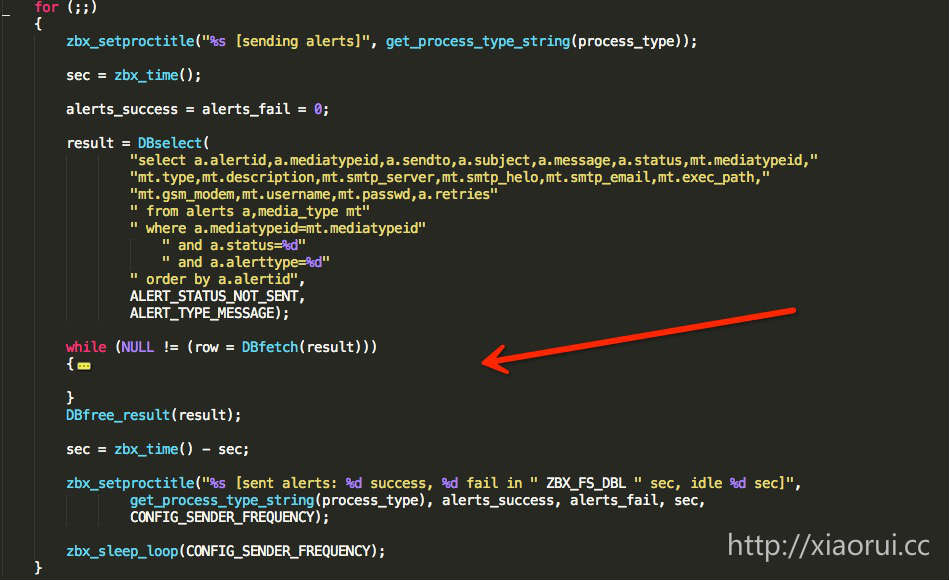前言:
晚上睡不着,想起白天和朋友聊监控系统,他以前在阿里和高德都做监控,算是个专业监控开发选手了。对于监控那哥们确实理解的深刻。过段时间去做嘉宾,要讲点监控的东西,为了防止吹牛逼,被人卡断。 So 随手下载了zabbix的代码,打开alerter.c文件看之,话说zabbix的c代码写的比较的鲜明。 其实还有一个原因就是,当时在乐视网做有关zabbix二次开发项目的时候,对于zabbix发出去的报警信息,我和大黄本来打算不调用第三方的脚本,直接用c来做http请求。后来因为各忙各的其他的项目,这个想法也就废掉了。
更多有关zabbix开发的文章,请关注 blog.xiaorui.cc
首先需要介绍的时execute_action 函数,这个函数是对于action相关联的mediatype,已经向db反馈成功还是失败的状态。
那我们根据在当初配置的media,做不同的动作。 比如是MEDIA_TYPE_EMAIL的话,那就连接stmp,发送邮件。 如果是EXEC的话,那就是fork进程,也就是第三方的系统调用。
if (MEDIA_TYPE_EMAIL == mediatype->type)
{
alarm(ALARM_ACTION_TIMEOUT);
res = send_email(mediatype->smtp_server, mediatype->smtp_helo, mediatype->smtp_email,
alert->sendto, alert->subject, alert->message, error, max_error_len);
alarm(0);
}
#ifdef HAVE_JABBER
else if (MEDIA_TYPE_JABBER == mediatype->type)
{
/* Jabber uses its own timeouts */
res = send_jabber(mediatype->username, mediatype->passwd,
alert->sendto, alert->subject, alert->message, error, max_error_len);
}
#endif
else if (MEDIA_TYPE_SMS == mediatype->type)
{
/* SMS uses its own timeouts */
res = send_sms(mediatype->gsm_modem, alert->sendto, alert->message, error, max_error_len);
}
else if (MEDIA_TYPE_EZ_TEXTING == mediatype->type)
{
/* Ez Texting uses its own timeouts */
res = send_ez_texting(mediatype->username, mediatype->passwd,
alert->sendto, alert->message, mediatype->exec_path, error, max_error_len);
}
else if (MEDIA_TYPE_EXEC == mediatype->type)
这下面是zabbix里面具体调用scripts脚本的过程。
if (0 == access(cmd, X_OK))
{
send_to = zbx_dyn_escape_string(alert->sendto, "\"\\");
subject = zbx_dyn_escape_string(alert->subject, "\"\\");
message = zbx_dyn_escape_string(alert->message, "\"\\");
zbx_snprintf_alloc(&cmd, &cmd_alloc, &cmd_offset, " \"%s\" \"%s\" \"%s\"",
send_to, subject, message);
zbx_free(send_to);
zbx_free(subject);
zbx_free(message);
if (SUCCEED == (res = zbx_execute(cmd, &output, error, max_error_len, ALARM_ACTION_TIMEOUT)))
{
zabbix_log(LOG_LEVEL_DEBUG, "%s output:\n%s", mediatype->exec_path, output);
zbx_free(output);
}
else
res = FAIL;
}
else
zbx_snprintf(error, max_error_len, "%s: %s", cmd, zbx_strerror(errno));
zbx_free(cmd);
上面的是关于触发action的相关函数,那肯定还有个在一直调用execute_action函数的主main函数吧。他的函数名字是 main_alerter_loop 。 既然是loop,那就知道他是做啥的了,逻辑很简单,zabbix_server 启动后,fork出main_alerter_loop函数来,让他独立负责报警这件事情。
关于zabbix日志记录逻辑:
zabbix_log(LOG_LEVEL_INFORMATION, "%s #%d started [%s #%d]", get_daemon_type_string(daemon_type), server_num, get_process_type_string(process_type), process_num);
创建一个DB连接的对象
DBconnect(ZBX_DB_CONNECT_NORMAL);
通过Mysql查询alerts未发送的任务,通过media查到行为的方式。
result = DBselect( "select a.alertid,a.mediatypeid,a.sendto,a.subject,a.message,a.status,mt.mediatypeid," "mt.type,mt.description,mt.smtp_server,mt.smtp_helo,mt.smtp_email,mt.exec_path," "mt.gsm_modem,mt.username,mt.passwd,a.retries" " from alerts a,media_type mt" " where a.mediatypeid=mt.mediatypeid" " and a.status=%d" " and a.alerttype=%d" " order by a.alertid", ALERT_STATUS_NOT_SENT, ALERT_TYPE_MESSAGE);
他是一次性的把没有发送,也就是未执行的报警任务,都给取出来,然后传递给execute_action去处理报警的逻辑。
ZBX_STR2UINT64(alert.alertid, row[0]); ZBX_STR2UINT64(alert.mediatypeid, row[1]); alert.sendto = row[2]; alert.subject = row[3]; alert.message = row[4]; alert.status = atoi(row[5]); ZBX_STR2UINT64(mediatype.mediatypeid, row[6]); mediatype.type = atoi(row[7]); mediatype.description = row[8]; mediatype.smtp_server = row[9]; mediatype.smtp_helo = row[10]; mediatype.smtp_email = row[11]; mediatype.exec_path = row[12]; mediatype.gsm_modem = row[13]; mediatype.username = row[14]; mediatype.passwd = row[15]; alert.retries = atoi(row[16]); *error = '\0'; res = execute_action(&alert, &mediatype, error, sizeof(error));
虽然有不同的触发动作,但是返回值的状态都一样。 下面的逻辑,是判断返回状态,入库或者是debug日志中。
if (SUCCEED == res)
{
zabbix_log(LOG_LEVEL_DEBUG, "alert ID [" ZBX_FS_UI64 "] was sent successfully",
alert.alertid);
DBexecute("update alerts set status=%d,error='' where alertid=" ZBX_FS_UI64,
ALERT_STATUS_SENT, alert.alertid);
alerts_success++;
}
else
{
zabbix_log(LOG_LEVEL_DEBUG, "error sending alert ID [" ZBX_FS_UI64 "]", alert.alertid);
error_esc = DBdyn_escape_string_len(error, ALERT_ERROR_LEN);
alert.retries++;
if (ALERT_MAX_RETRIES > alert.retries)
{
DBexecute("update alerts set retries=%d,error='%s' where alertid=" ZBX_FS_UI64,
alert.retries, error_esc, alert.alertid);
}
else
{
DBexecute("update alerts set status=%d,retries=%d,error='%s' where alertid=" ZBX_FS_UI64,
ALERT_STATUS_FAILED, alert.retries, error_esc, alert.alertid);
}
zbx_free(error_esc);
alerts_fail++;
}
}
最后的几段话意思是,统计时间及sleep 30秒后,再继续下一轮。
sec = zbx_time() - sec;
zbx_setproctitle("%s [sent alerts: %d success, %d fail in " ZBX_FS_DBL " sec, idle %d sec]",
get_process_type_string(process_type), alerts_success, alerts_fail, sec,
CONFIG_SENDER_FREQUENCY);
zbx_sleep_loop(CONFIG_SENDER_FREQUENCY);
通过server.c确定zabbix 每次alert间隔的时间了。
[xiaorui@devops zabbix-2.4.2 ]grep 'CONFIG_SENDER_FREQUENCY' src/zabbix_server/server.c
int CONFIG_SENDER_FREQUENCY = 30;
[xiaorui@devops zabbix-2.4.2 ]
我先前一直好奇,他报警的时候,是不是串行的,先前也看了官方的介绍说是串行执行的。奇怪了看他的函数定义的地方,发现有多线程的逻辑,不知道为啥没有应用上,而是用while一直遍历数据库返回的列表数据。

有时间把zabbix的有关alert的代码做个patch,真的很想知道,把zabbix做成http报警后,在报警多的时候,会不会能力很突出。 希望我的这篇文章,能对那些做zabbix二次开发的有所帮助。



我靠呀,你在51cto的时候,发文章频率就很高,现在也是半夜发文章 !